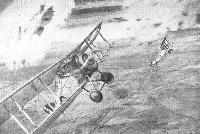
Варианты
- Sopwith - Buffalo - 1918 - Великобритания
- Sopwith - Dragon - 1918 - Великобритания
- Sopwith - Salamander / T.F.2 - 1918 - Великобритания
- Sopwith - Snipe / 7F.1 - 1918 - Великобритания
Sopwith Salamander
Для нанесения ударов по наземным целям предназначался самолет Salamander TF.2, спроектированный на основе Snipe. Стандартное вооружение из двух пулеметов Vickers на нем сохранили, но дополнительно испытали различные варианты вооружения, позволявшего вести огонь вниз. До завершения производства в 1919 году построили 82 Salamander TF.2, но лишь немногие из них успели попасть во Францию раньше, чем война окончилась. В боях самолеты не применялись вообще, а вскоре после окончания войны были сняты с вооружения британских ВВС.
- Описание
Фотографии
-
Aeroplane Monthly 1984-08 / R.Baxter - The Sopwith interview (2)
Регистрационный номер: E5429 [4] A view of the first prototype Salamander, E5429, photographed at Brooklands on 1 May 1918.
The Sopwith Salamander trench-fighter, powered by a 200 h.p. Bentley rotary. This aircraft, E5429, was the prototype, and it was first flown on April 27, 1918, from Brooklands. Though production continued after the Armistice the Salamander never equipped a squadron. -
Мировая Авиация 240
Регистрационный номер: E5429 [4] Для защиты от огня с земли на Salamander была установлена бронезащита суммарной массой 295 кг. Броня прикрывала летчика и топливные баки.
-
Air International 1979-04 / J.Bruce - The First British Armoured Brigade (3)
Регистрационный номер: E5429 [4] Capt H B Robin Rowell in the cockpit of E5429 at Brooklands shortly before taking off for France on 9 May 1918. The Naval officer at right is Lt Denis Allen.
-
Air International 1979-04 / J.Bruce - The First British Armoured Brigade (3)
Регистрационный номер: E5431 [2] The third prototype Salamander, E5431, photographed at Martlesham Heath, where it had arrived for official trials on 24 June 1918. Note the double control levers on the ailerons and the corresponding double inter-aileron wires.
-
Air International 1979-04 / J.Bruce - The First British Armoured Brigade (3)
Регистрационный номер: F6533 Salamander F6533 photographed at McCook Field in the USA.
-
Air International 1979-04 / J.Bruce - The First British Armoured Brigade (3)
Регистрационный номер: F7801 The first Salamander built by the Air Navigation Co, F7801, here seen at Brooklands. It had plain upper ailerons and the early production fin and rudder and was painted in the standard Salamander camouflage scheme. Note the absence of rudder stripes and fuselage roundels.
-
Air International 1979-04 / J.Bruce - The First British Armoured Brigade (3)
Регистрационный номер: F6524 Production Salamander F6524 photographed at Villacoublay while undergoing evaluation by the Section Technique de l’Aeronautique. Like F6533, it has plain upper ailerons, small fin and original rudder.
-
Air International 1979-04 / J.Bruce - The First British Armoured Brigade (3)
Регистрационный номер: E5431 [2] Two views of E5431 painted in the experimental camouflage scheme mentioned in the text; this formed the subject of an official description in Confidential Information Memorandum No 733 dated 3 September 1918. Four colours were used; Dark Purple Earth, Green, Light Green-Grey and Light Earth; and the outline of each area was picked out by a black line varying in width from 2 in to 4 in (51 mm to 102 mm). The upper-wing roundels were of different diameters, presumably to confuse the aim of attacking aircraft.
-
Air International 1979-04 / J.Bruce - The First British Armoured Brigade (3)
Регистрационный номер: J5913 Glendower-built Salamander J5913, said to be at Minchinhampton. The aircraft wears the camouflage scheme first tried on E5431 but has no roundel on the upper wing visible in this photograph.
-
Air International 1979-04 / J.Bruce - The First British Armoured Brigade (3)
Регистрационный номер: F6602 [2] Final form of the production Salamander, with balanced upper ailerons and enlarged fin and rudder, exemplified by F6602. These photographs are dated 25 January 1919.
-
Air International 1979-04 / J.Bruce - The First British Armoured Brigade (3)
Регистрационный номер: F6602 [2] Final form of the production Salamander, with balanced upper ailerons and enlarged fin and rudder, exemplified by F6602. These photographs are dated 25 January 1919.
-
Air International 1979-04 / J.Bruce - The First British Armoured Brigade (3)
A camouflaged production Salamander photographed at Heliopolis, Egypt, in 1922. It is carrying four 20-lb (9,1-kg) Cooper bombs in the rack under the fuselage.
-
Air International 1979-04 / J.Bruce - The First British Armoured Brigade (3)
Регистрационный номер: E5429 [4] The armoured portion of the first Sopwith Salamander, E5429, under construction. The double rear wall can be seen.
-
Air International 1979-04 / J.Bruce - The First British Armoured Brigade (3)
The forward fuselage of a production Salamander. Apart from the staggered guns the design of the armour plate differs in detail.
-
Air International 1979-04 / J.Bruce - The First British Armoured Brigade (3)
Salamanders in production in the Addle stone works of the Air Navigation Company.
-
Flight 1920-06 / Flight
THE IMPERIAL WAR MUSEUM, AIRCRAFT SECTION: An R.E.8, Sopwith Salamander, Sopwith triplane and Bristol Fighter
Другие самолёты на фотографии: Bristol F.2A/F.2B Fighter - Великобритания - 1916RAF R.E.8 - Великобритания - 1916Sopwith Triplane - Великобритания - 1916
-
Flight 1920-05 / Flight
ARMOURED SCOUTS ZOOMING.
-
Air International 1979-04 / J.Bruce - The First British Armoured Brigade (3)
Sopwith Salamander
-
Авиация и Космонавтика 2001-03 / В.Перов, О.Растренин - Пехотный самолет /Самолеты поля боя/ (1)
Схема британского штурмовика Сопвич "Саламандра"
- Фотографии


















